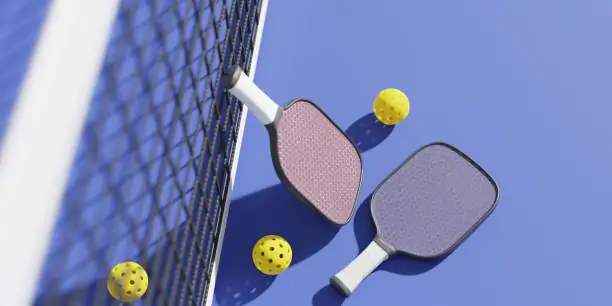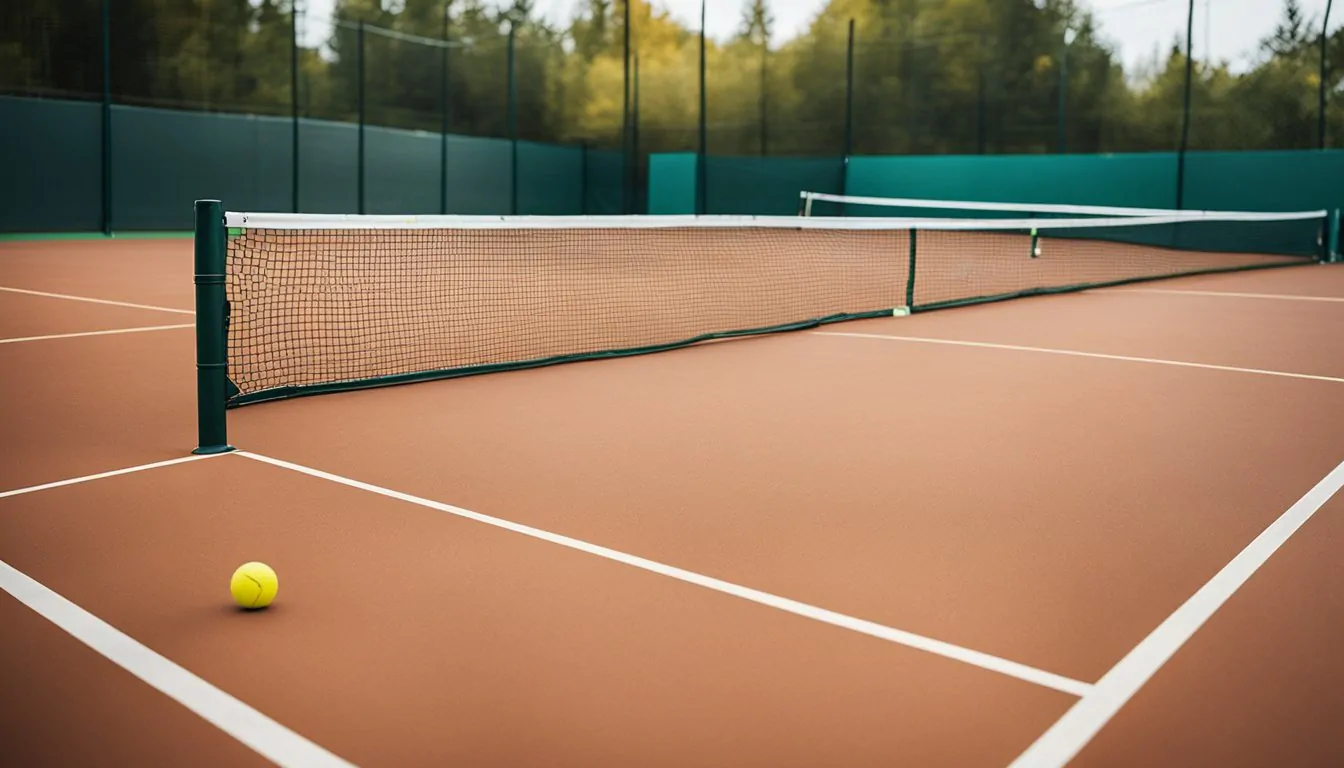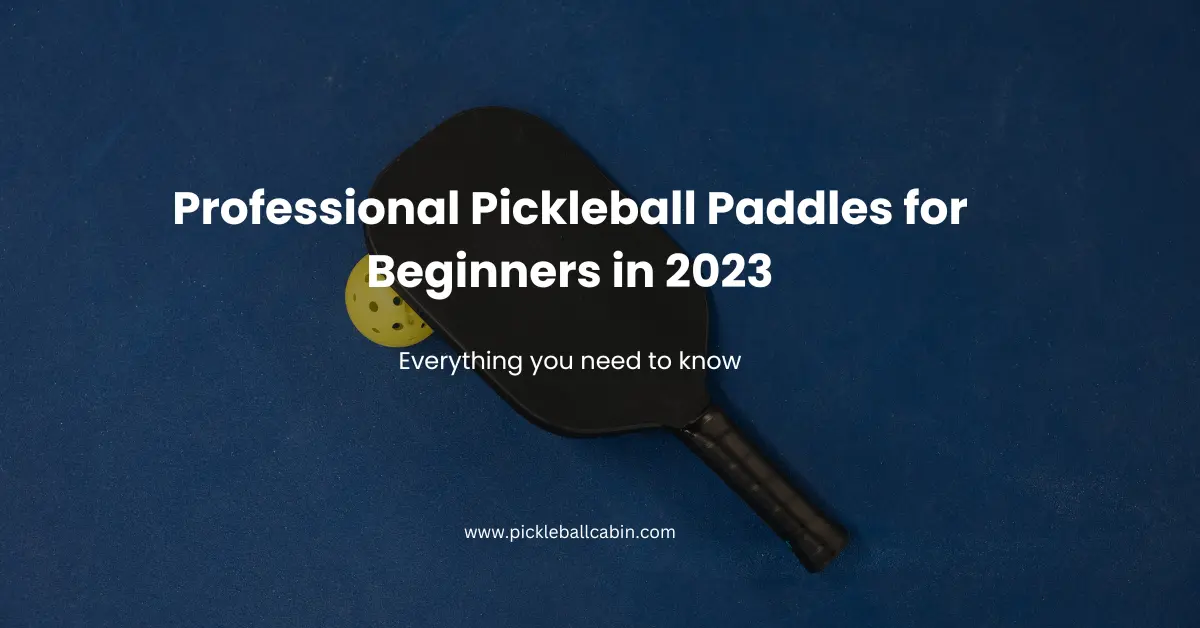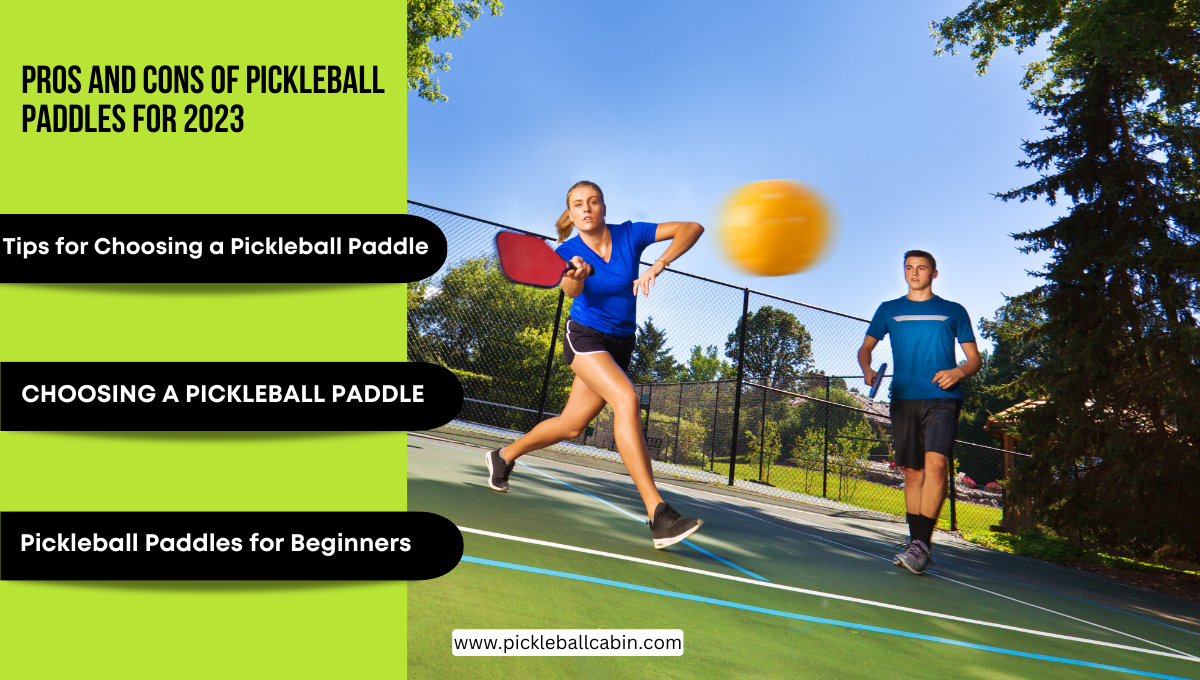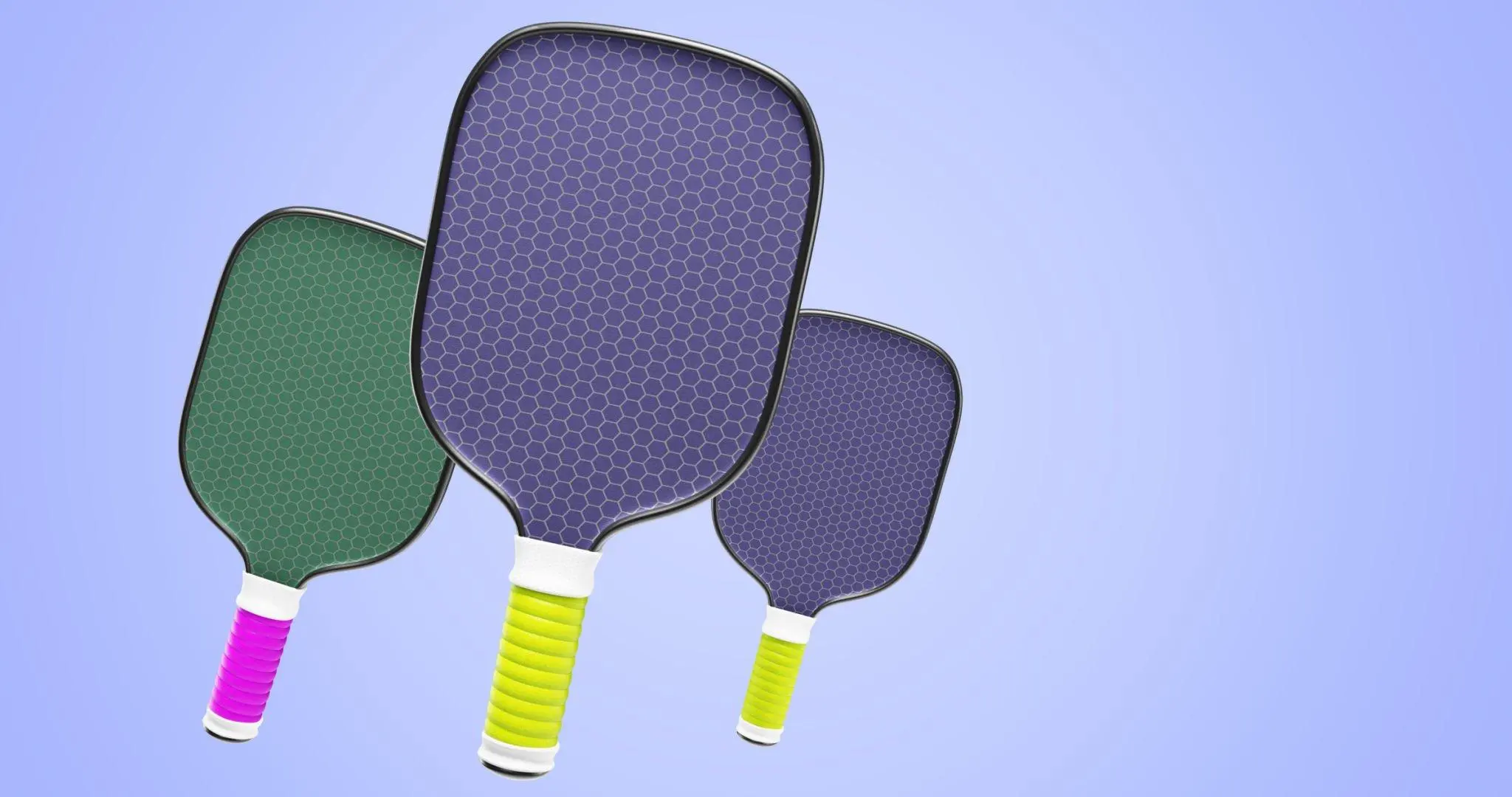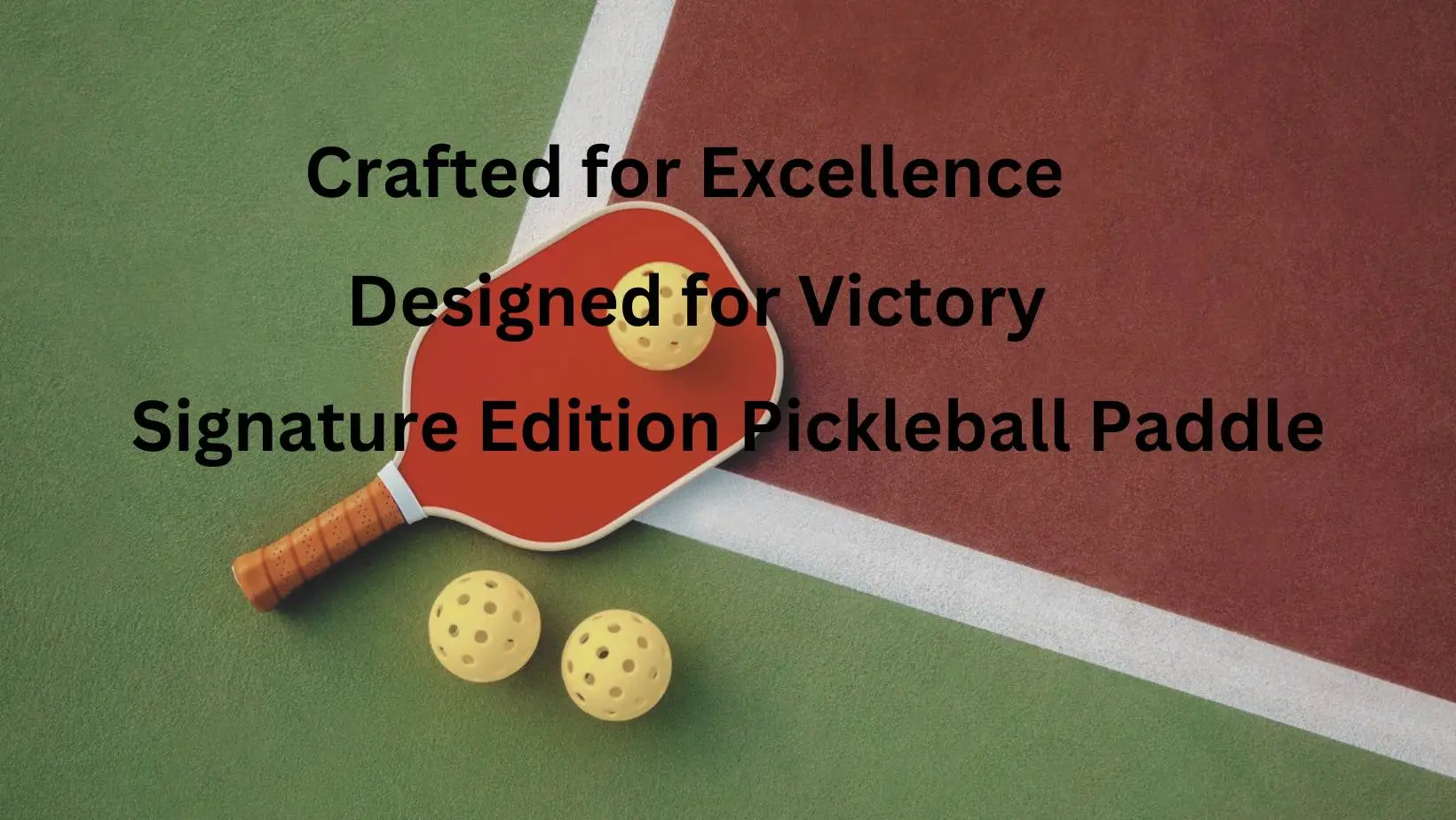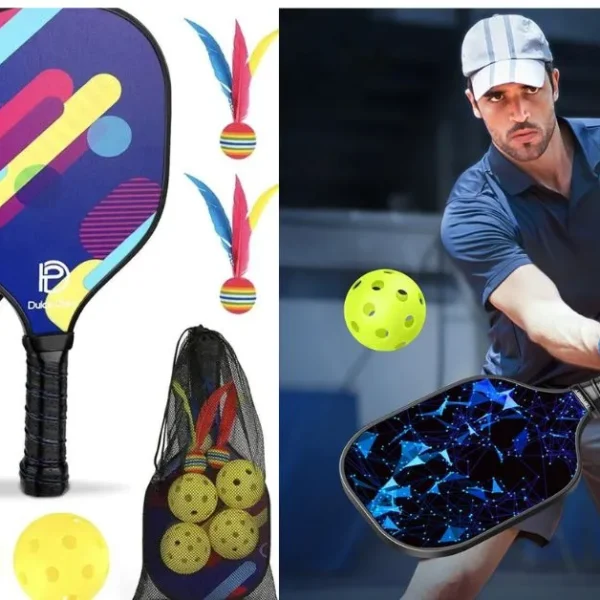Pickleball has quickly gained popularity in recent years, emerging as one of the most beloved racket sports worldwide. This fast-paced game combines elements of tennis, badminton, and ping pong, making it accessible to players of all ages and skill levels.
Especially during the pandemic, pickleball has seen a remarkable surge in popularity as people sought outdoor recreational activities that adhered to social distancing guidelines. Its simple and adaptable rules make it easy for beginners to pick up, while still providing a challenge for experienced players.
The game is played on a court that resembles a tennis court but is smaller in size. Players utilize solid paddles to strike a plastic ball over a net. The objective is to keep the ball in play and land it within the opponent’s court.
What sets pickleball apart is its social nature, promoting inclusivity and camaraderie among players. It can be played singles or doubles, allowing friends and families to engage in friendly competition or form teams for tournaments. This accessibility has also attracted tennis players who are looking to try something new and expand their racket sport repertoire.
Whether you’re a beginner or advanced player, finding the right pickleball paddle is crucial to enhance your performance on the court. Different paddles offer varying degrees of power, control, and maneuverability to cater to individual playing styles and skill levels.
In our next section, we will explore the various types of pickleball paddles and discuss their features in detail to help you find the perfect one for your game.
Definition and purpose of pickleball paddles
Pickleball paddles are essential equipment used in the popular sport of pickleball. These paddles are used to hit the ball back and forth over the net during gameplay. They come in a variety of types and materials, each offering unique characteristics to suit different skill levels and playing styles.
Pickleball paddles can be categorized based on their materials, with options such as wooden, composite, and graphite paddles. Wooden paddles are often favored by beginners due to their affordability and ease of use.
Composite paddles, on the other hand, offer a balance of power and control and are commonly used by intermediate to advanced players. Graphite paddles, known for their lightweight and durability, are popular among experienced players.
The shape of the paddle also plays a role in its performance. Some paddles have an elongated shape, providing a larger sweet spot for extra power and control. Others have a wider surface, ideal for beginners or players who prioritize a forgiving paddle. The core material of the paddle, like polypropylene honeycomb, also affects its weight and feel.
Whether you’re a beginner looking for a paddle to enhance your skills or an advanced player seeking more power or control, there is a wide selection of paddles available to suit your needs. Understanding the different types and materials will help you make an informed choice and find the perfect paddle that complements your playing style.
Why Your Pickleball Paddle Choice Can Make or Break Your Game!
Choosing the right pickleball paddle is of utmost importance for players of all skill levels. The paddle you select can greatly impact your performance on the court, affecting aspects such as power, control, and maneuverability.
For beginners, a paddle that offers more control and forgiveness may be ideal, allowing them to develop their skills and improve their accuracy.
Advanced players, on the other hand, might opt for a paddle that provides more power and precision to match their playing style and strategies.
It’s essential to consider factors such as weight, comfortable grip, material, and paddle shape when making your selection. By finding the perfect pickleball paddle, you can enhance your game and enjoy a more competitive and fulfilling playing experience.
Buying a Pickleball Paddle: Important Factors to Consider (Guide)
When it comes to buying a pickleball paddle, there are several factors to consider in order to find the perfect racket for your playing style and skill level. From paddle weight and shape to construction and durability, each element plays a role in determining your overall performance on the court.
Paddle Weight
Firstly, paddle weight is an important consideration. Heavier paddles typically offer more power, making them ideal for players who rely on strength and hitting hard shots. Lightweight paddles, on the other hand, are maneuverable and allow for quick reactions, making them a great choice for players who prioritize speed and agility.
Certainly! Here’s a table showcasing different weights of pickleball paddles:
| Paddle Weight | Description |
|---|---|
| Lightweight | Paddles weighing less than 7.5 oz |
| Medium | Paddles weighing 7.5 – 8.5 oz |
| Heavy | Paddles weighing more than 8.5 oz |
Please note that these weight categories are approximate and can vary slightly between manufacturers.
The weight of a paddle plays a crucial role in determining its “feel” when held and the kind of performance it delivers on the court. It is primarily a matter of personal preference influenced by your fitness level and playing style.
Let’s take a moment to consider the unlikely association between a can of soup and pickleball. While it may appear as an odd example, it serves the purpose of illustrating that something initially lightweight can become noticeably heavy when you swing it repeatedly during gameplay. The strain is particularly evident in your wrist, elbow, and shoulder.
Those additional ounces carried by a heavier paddle will gradually take a toll on your body, especially if you already have conditions like tennis elbow or arthritis. Consequently, it becomes crucial to choose a paddle weight that aligns with your physical capabilities and minimizes the risk of exacerbating any existing injuries or discomfort.
Certainly! Here’s a table comparing the pros and cons of light and heavy pickleball paddles:
| Light Paddles | Heavy Paddles |
|---|---|
| Pros: | Pros: |
| – Easy to maneuver and control the paddle | – Provide more power and stability |
| – Suitable for players seeking quick reaction times | – Can generate more momentum and force in shots |
| – Less strain on the arm and wrist during extended play | – Absorb more shock and vibrations from hard-hitting shots |
| Cons: | Cons: |
| – May offer less power and speed in shots | – Can be more tiring to use over extended periods of play |
| – Less stability and resistance against strong shots | – May require more strength and effort to maneuver effectively |
| – Not as effective for blocking hard-hitting shots | – Reduced maneuverability and agility |
Please note that the suitability of paddle weight depends on individual preferences, playing style, and skill level. It’s important to try out different paddle weights to determine which one works best for you.
Paddle Shape
Shape is another crucial factor to consider. Paddles with an elongated shape generally provide a larger sweet spot, resulting in increased power and control. On the contrary, paddles with a wider surface offer a more forgiving paddle, making them suitable for beginners or those who prefer a larger margin of error.
Certainly! Here’s a table showcasing different shapes of pickleball paddles:
| Paddle Shape | Description |
|---|---|
| Standard | Traditional paddle shape with a widebody and standard-sized face |
| Widebody | Paddle with a wider body and larger face area for more surface contact |
| Narrow | Paddle with a narrower body and smaller face area for maneuverability |
| Tear Drop | Paddle with a tapered shape, wider at the top and narrower at the handle |
| Hybrid | Paddle with a combination of features from different shapes |
Please note that these paddle shapes are general categories, and individual paddle models may have slight variations within each shape.
Paddle Size
The length of the paddle can also impact your game. Longer paddles offer extended reach, allowing you to cover more ground and reach difficult shots. Shorter paddles, on the other hand, provide better maneuverability and are favored by players who prioritize finesse and accuracy.
Certainly! Here’s a table showcasing different sizes of pickleball paddles:
| Paddle Size | Dimensions |
|---|---|
| Small | Face size less than 81 sq. in. |
| Medium | Face size between 81 – 95 sq. in. |
| Large | Face size greater than 95 sq. in. |
Please note that these size categories are approximate and can vary slightly between manufacturers.
Construction and durability
Construction and durability are also important factors. Composite paddles, such as those made from graphite or fiberglass, offer a great balance of power and control while being durable. Wooden paddles are affordable and suitable for beginners but tend to be less durable.
Paddle Material: A Key Factor in Pickleball Performance
When it comes to pickleball paddles, the material they are made of plays a crucial role in overall performance and gameplay. The choice of paddle material can greatly affect a player’s ability to control the ball, generate power, and even prevent injury.
One popular material used in pickleball paddles is composite. Composite paddles are made from a blend of materials such as fiberglass, carbon fiber, and polymers. These paddles offer a great balance of power and control, making them suitable for players of all skill levels. They are known for their durability and ability to absorb the impact of the ball, reducing the risk of strain or injury to the player.
On the other hand, some players prefer heavier paddle options. Heavier paddles, often made of materials like wood or graphite, allow for more power in swings and shots. These paddles can be beneficial for power players who rely on aggressive shots and strong hits.
However, they may require more arm strength and can be less maneuverable for players who prioritize quick, finesse shots.
Conversely, lightweight paddles are favored by players who value speed and quick reactions. These paddles are typically made from lighter materials such as composite or aluminum. They offer excellent control, allowing players to respond swiftly to fast-paced rallies and make precise shots.
Lightweight pickleball paddles are especially popular among beginners and those who prioritize accuracy and finesse over power.
Apart from the choice between heavier and lighter paddles, the shape and size of the paddle can also impact gameplay. Elongated paddles, usually measuring around 17 inches wide, offer a larger sweet spot and provide better reach. They are often recommended for advanced players looking for maximum control and power.
On the other hand, more compact, traditional-shaped paddles offer a balance between power and maneuverability, making them a popular choice among players of all levels.
Considering these key factors, finding the perfect pickleball paddle depends on your playing style, skill level, and personal preferences. It’s important to try different paddles and weights to find the one that suits you best
Discover the perfect grip size for your game!
One crucial factor that often goes overlooked when selecting a pickleball paddle is the grip size. Finding the right grip size is of utmost importance as it directly impacts a player’s performance and overall comfort during gameplay.
Smaller Grip Size
A smaller grip size offers several advantages for pickleball players. It allows for enhanced wrist action, enabling players to put more spin on their shots and have better control over the paddle.
This increased control translates into precise ball placement, which is crucial for players who prioritize finesse and accuracy in their gameplay.
Larger Grip Size
Larger grip size provides stroke stability and reduces strain on the joints. This is especially beneficial for players who have larger hands or suffer from arthritis or other joint-related issues.
A larger grip helps in distributing the impact across a wider area, reducing the risk of injuries and discomfort during prolonged gameplay.
Discover the secret behind finding your perfect grip size!
To measure your grip size for a pickleball paddle, you can use the ring finger measurement method. Grip size can also be determined based on your height, with specific grip sizes recommended for different heights.
Certainly! Here’s a table that provides a general guideline for selecting the appropriate grip size based on the player’s height:
| Player Height | Grip Size (inches) |
|---|---|
| Under 5’2″ | 4 inches or smaller |
| 5’2″ – 5’8″ | 4.125 – 4.25 |
| 5’9″ – 6’2″ | 4.375 – 4.5 |
| Over 6’2″ | 4.625 and above |
To measure grip size using the ring finger method, begin by holding the paddle as you would during gameplay. Then, slide your playing hand’s ring finger between the tips of your fingers and the base of your palm. The grip size is correct if your finger fits snugly in the gap. Make sure there is not excessive space or finger movement, as this can affect your control and comfort while playing
Grip size recommendations vary based on height. Players who are under 5’2″ are generally recommended to use a 4-inch grip. Those between 5’3″ and 5’8″ can opt for a 4.25-inch grip. Players standing between 5’9″ and 6’2″ should consider a 4.5-inch grip, while players taller than 6’2″ might find a 4.75-inch grip size more suitable
Selecting the right grip size is crucial for comfort and performance in pickleball. By measuring your grip size using the ring finger method and considering your height-based recommendations, you can ensure a snug and comfortable fit for optimal gameplay.
Ring Finger Measurement:
To determine the correct racket grip size, pickleball players can use a ruler to measure their hand size. Start by measuring from the tip of the ring finger to the crease in the center of the palm, where the hand has three folds.
Checking for a Proper Grip:
To ensure a proper grip, follow these steps:
- Hold the racquet in a normal, natural grip.
- Slide the index finger of your other hand between the fingers and the palm of the clasped hand.
- Your fingers should comfortably wrap around the grip without any strain or need for adjustment.
- If there is excessive space between the heel of your hand and the fingers, and the index finger does not touch the grip, it indicates that the grip size is too large.
- Conversely, if you have to adjust or move your fingers to accommodate the index finger into the gap, your grip may be too weak.
- When choosing between two grip sizes, opt for the smaller size to ensure a better fit and control.
Please note that these guidelines are intended to help players assess grip size and achieve a comfortable hold on the racket, enhancing their performance and minimizing the risk of injury.
Core Construction: How it Impact on Your Performance:
When it comes to pickleball paddles, the core construction plays a vital role in determining the paddle’s performance and playing characteristics.
There are three main types of core construction commonly used in pickleball paddles: polymer cores, aluminum cores, and Nomex honeycomb cores.
Polymer (Poly) Core
Polymer (Poly) Core paddles are popular among pickleball players for their versatile performance and balanced characteristics. These paddles are made from a plastic blend that offers a unique combination of power and control on the court.
One notable advantage of polymer core paddles is their quietness. The plastic material used in their construction absorbs the impact of the ball, resulting in a noticeably softer and quieter playing experience. This makes them a preferred choice for players who value a peaceful and enjoyable game.
Polymer core paddles are particularly beneficial for control players. The balanced performance of these paddles allows players to have precise control over their shots, making it easier to place the ball exactly where intended. The softer feel of the paddle also helps control players finesse their shots and maintain accuracy.
Additionally, polymer core paddles are ideal for beginner players who are still developing their skills. The forgiving nature of these paddles helps beginners improve their control and consistency. The balanced power and control offered by polymer cores provide a stable and enjoyable playing experience that enhances a beginner’s learning curve.
Aluminum cores
Aluminum cores, on the other hand, are preferred by players who value lightweight and maneuverability. These cores are made from an aluminum material, which makes the paddle lighter and easier to handle. Aluminum core paddles are great for players who rely on quick reactions and swift movements on the court.
Aluminum core paddles are preferred by players who value a lightweight racket and fast maneuverability. These paddles have a larger surface area compared to other pickleball paddle types.
Nomex Honeycomb Cores
Nomex honeycomb cores are known for their power and durability. These cores consist of a honeycomb structure made from Nomex, a lightweight material. Paddles with Nomex cores offer exceptional power and punch, making them a popular choice among power players.
They also provide excellent stability and control, giving players the confidence to place shots precisely.

Noise
When it comes to the game of pickleball, the noise generated by pickleball paddles is an important consideration for players and those around them. The sound produced during gameplay can vary based on several factors, including the type of paddle material and the player’s technique. Pickleball paddles are typically constructed using materials such as graphite, composite, or wood, each with its own acoustic properties.

Players who prefer a quieter playing experience may opt for paddles made from softer materials like wood, as they tend to generate less noise upon impact with the ball.
Alternatively, paddles made from graphite or composite materials may produce a slightly louder sound due to their sturdier construction. It’s worth noting that certain tournaments and venues have specific noise regulations in place, which players must adhere to.
By understanding the impact of different paddle materials on noise production and considering tournament guidelines, players can choose the right pickleball paddle to suit their preferences and meet noise requirements.
Power vs. Control Pickleball Paddles: Finding the Right Balance:
Pickleball is a sport that requires skill, strategy, and the appropriate equipment. When selecting a pickleball paddle, several factors should be taken into account, including power and control.
These two elements have a significant influence on the game and can greatly affect a player’s performance.
Power Pickleball Paddles
Power pickleball paddles are designed for players who rely on their strength and aggressiveness to dominate the game. These paddles are often heavier and have larger sweet spots, providing more power in each shot. The weight of the paddle allows players to generate more momentum, resulting in stronger and faster shots.
Power paddles are favored by players who are experienced, strong, and have a more aggressive playing style. They are also suitable for players transitioning from other racket sports, such as tennis, where power is crucial
Control Pickleball Paddles
Control pickleball paddles are designed for players who prioritize accuracy, finesse, and placement over sheer power. These paddles are typically lighter in weight, allowing for better maneuverability and control during shots.
Control paddles have a smaller sweet spot, which requires players to have precise technique and touch to achieve desired placement and spin. These paddles provide great control over the ball, allowing players to dictate the pace and direction of the game.
They are preferred by players who value precision and rely on strategy and finesse to outsmart their opponents.
While some pickleball players find themselves naturally inclined towards power or control, others may struggle to find the perfect balance. In such cases, paddle manufacturers have introduced hybrid paddles that aim to provide a combination of power and control.
These paddles are designed to strike a balance between the two, providing players with the best of both worlds. Hybrid paddles often have a mid-weight and an average-sized sweet spot, allowing players to generate respectable power while maintaining control over their shots.
Ultimately, the decision between power and control comes down to a player’s individual style, strengths, and preferences. Experienced players who enjoy a more aggressive playstyle may benefit from a power paddle. On the other hand, players who value finesse, accuracy, and strategic gameplay might opt for a control paddle.
A paddle with greater weight can achieve a shot over the net with reduced force. Considering these aspects, we recommend pickleball players suffering from tennis elbow to opt for a mid-weight pickleball paddle, typically weighing between 7.3 and 8.4 ounces, made of graphite or composite materials.
Tip for former tennis players:
If you are transitioning from tennis to pickleball, you may already be accustomed to the heavier weight of a tennis racket. Consequently, you should find it manageable to use a paddle on the heavier end of the weight range.
However, if you heavily rely on wrist movements in your shots, it might be more beneficial to choose a paddle with a lighter to medium weight. Such paddles allow for increased finesse and control.
While selecting a pickleball paddle, it is also advisable to consider “tennis style” grips that mimic the handle of a tennis racquet. Numerous new elongated grips are available, which many tennis players will find appealing as they provide a similar feel to a traditional tennis racket.
Types of Pickleball Paddles
There are several types of pickleball paddles available on the market, each with its own unique characteristics
Composite paddles
Composite pickleball paddles are made from a blend of materials like fiberglass, carbon fiber, and polymers. They offer a great balance of power and control, making them suitable for players of all skill levels. These paddles are known for their durability and ability to absorb the impact of the ball, reducing the risk of strain or injury.

Wooden Paddles:
Wooden pickleball paddles are popular among traditionalists and players who prefer a solid feel. They offer a unique touch and are often more affordable than other types of paddles. However, wooden pickleball paddles tend to be heavier and may not provide the same power or control as composite or graphite paddles.

Graphite Paddles:
Graphite pickleball paddles are lightweight and offer excellent control, making them perfect for players who prioritize finesse and accuracy. They also provide good power, making them suitable for both intermediate and advanced players. Graphite pickleball paddles are often more expensive than other types but are a popular choice for players looking for a high-quality, high-performance paddle.
Edgeless Paddles:
Edgeless pickleball paddles have a unique design where the edge of the paddle is smoothed out. This design increases the paddle’s sweet spot and provides a larger hitting area. Edgeless paddles are great for players who want a forgiving paddle and maximize their shot-making potential.

Elongated Paddles:
Elongated pickleball paddles are wider than traditional paddles, usually measuring around 17 inches or more. These paddles offer a larger sweet spot and better reach, providing maximum control and power. They are often recommended for advanced players looking to enhance their game through increased hitting surface.

Mid-weight Paddles:
Mid-weight pickleball paddles strike a balance between power and maneuverability. They cater to a wide range of players and playing styles. Mid-weight paddles are often made with composite materials and offer good control, power, and stability.

Pickleball Paddles Prices: Finding the Perfect Balance of Quality and Affordability
When it comes to pickleball paddles, price can play a significant role in your selection. With a wide range of options available, it’s essential to consider your budget and find a paddle that suits your needs without breaking the bank.
The price of pickleball paddles can vary depending on various factors such as brand, materials used, design features, and overall quality. Generally, pickleball paddles are available in a wide price range to accommodate different budgets.
Entry-level or beginner paddles can be found in the range of $20 to $50. These paddles are typically made of basic materials and may have simpler designs.
Mid-range paddles, which provide a combination of enhanced performance and durability, typically fall within the price range of $50 to $100. These paddles often have improved construction, enhanced grip, and better control.
High-end or professional-grade paddles can be priced above $100. These pickleball paddles are typically made with premium materials, advanced technologies, and are designed for maximum performance and precision.
It’s worth noting that prices can vary based on factors such as paddle weight, grip size, brand reputation, and any additional features or technologies incorporated into the design.
It’s recommended to research different brands, read customer reviews, and consider your own playing style and preferences when choosing a pickleball paddle.
Whether you’re a casual beginner or an advanced player, it’s crucial to find a pickleball paddle that fits your budget without compromising on quality. There are numerous options available that offer a wide range of prices to accommodate different players’ needs and skill levels. So, take your time to research and find the perfect paddle that suits your style of play and ensures a great pickleball experience.
Maintenance and Care for Pickleball Paddles
Proper maintenance and care for pickleball paddles are essential to ensure their longevity and optimal performance on the court. By following a few simple guidelines, players can extend the lifespan of their paddles and maximize their investment.
Here are some tips to help you keep your pickleball paddles in excellent condition:
- Clean the Paddle: After each game or practice session, wipe down the paddle with a damp cloth or sponge to remove any dirt, sweat, or debris. Avoid using harsh chemicals or abrasive materials that could damage the pickleball paddle’s surface.
- Avoid Extreme Temperatures: Extreme heat or cold can affect the performance and durability of your pickleball paddle. Avoid leaving it in direct sunlight or in a freezing car trunk for extended periods. Store your paddle in a cool, dry place when not in use.
- Protect the Edge Guard: Many pickleball paddles have an edge guard that protects the edges of the paddle face. Make sure the edge guard is securely attached and in good condition. If it becomes loose or damaged, consider replacing it to prevent further damage to the paddle.
- Check for Cracks or Damage: Regularly inspect your pickleball paddle for any cracks, dents, or other signs of damage. If you notice any issues, it’s best to address them promptly to prevent further deterioration. Depending on the severity of the damage, you may need to repair or replace the paddle.
- Use a Paddle Cover: Investing in a pickleball paddle cover is a great way to protect your paddle during transportation or storage. A cover will shield your paddle from accidental impacts, scratches, and dust.
- Avoid Excessive Force: While pickleball is an energetic and competitive game, avoid using excessive force when hitting the ball. Hitting the ball too hard or frequently hitting the paddle against hard surfaces can lead to premature wear and damage.
- Rotate Paddles: If you have multiple paddles, consider rotating their usage. This can help distribute the wear and tear evenly across the paddles and prolong their lifespan.
Encouragement to explore and enjoy the game of pickleball with the per
Encouraging readers to explore and enjoy the game of pickleball has become increasingly important, especially during the pandemic. This uniquely playable sport has gained immense popularity due to its social, inclusive, and enjoyable nature.
During these challenging times, pickleball has emerged as a go-to activity for individuals looking to stay active, engage with others, and have fun. It offers the perfect blend of physical exercise and social interaction, making it an ideal choice for people of all ages and skill levels.
Pickleball has quickly become a powerhouse in the world of sports, entertainment, fashion, and lifestyle. With professional tournaments offering substantial payouts and major broadcast deals, the sport has garnered attention from both players and spectators alike.
Additionally, pickleball courts are popping up across the nation, providing more opportunities for people to discover and embrace the game.
Exploring and enjoying pickleball can have a positive impact on both physical and mental well-being. Whether you are a seasoned athlete or new to racket sports, the game offers a low-impact workout that improves agility, coordination, and cardiovascular health. Plus, the friendly and inclusive nature of pickleball fosters a sense of community and camaraderie among players.
So, grab a paddle, head to the court, and join the pickleball craze. Discover the joy of this addictive game, make new friends, and experience the many benefits it has to offer. Don’t miss out on the opportunity to explore and enjoy the game of pickleball—it’s a sport that’s meant to be played and celebrated by all.
Final thoughts and recommendations for readers
In conclusion, choosing the appropriate pickleball paddle is crucial for improving your performance and enjoyment of the game. Your paddle selection can significantly affect your power, control, and comfort while playing.
Every player has a unique playing style and requires a paddle that caters to their individual needs. Whether you are a power player or a control player, there is a paddle out there that can complement your style. Additionally, personal preferences such as paddle weight, shape, and surface texture should also be taken into account.
To find the perfect pickleball paddle for you, I recommend demoing or trying out different paddles. Many pickleball retailers offer paddle demo programs, which allow you to test various paddles before making a purchase. This hands-on experience will help you determine which paddle feels comfortable in your hand and suits your playing style the best.
Remember, the right pickleball paddle is a game-changer. So take the time to explore different options, gather recommendations from other players, and find the paddle that will elevate your performance and enjoyment of pickleball.
